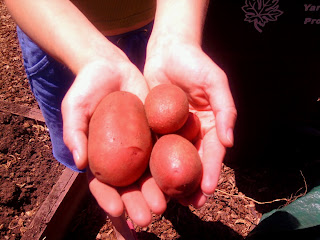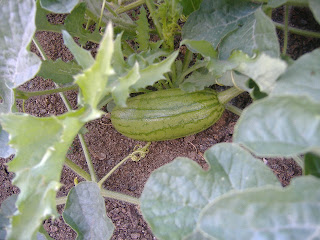Alright -- I'm not too proud to admit it. I do have this rather strange habit of drooling in front of any sort of vine-ripened fruit. I'm sorry -- but it's just one of those annoying little habits that developed over a period of decades. I can't help myself. Really, I can't! I mean -- just look at those LUSCIOUS -- not-quite-ripe -- blackberries to your right!
How can anyone not drool at a sight like that?
However -- I do have a eerie feeling that is why the good Master Gardeners at the Fair Oaks Horticulture Center haven't extended an invitation to me yet to attend the upcoming Harvest Festival. I can't blame them really. The whole idea is to *excite* people into growing fresh fruit. Looking at some weirdo who can't keep his mouth shut in front of a blackberry vine? Not what the good people at the Horticulture Center ordered.
Alas -- I can't blame them.
But photos such as this -- and a whole lot more -- is what you'll find at the upcoming Harvest Festival -- which takes place on the first Saturday in August -- August 7th -- at the Fair Oaks Horticulture Center on Fair Oaks Blvd. in the wonderful community of Fair Oaks no less (11549 Fair Oaks Boulevard to be exact).
Venus and I visited just under two months ago -- during a free open house -- where we were looking for and obtained table grape starter plants. And not just any table grapes mind you -- but the table grapes that tend to peform exceptionally well in our Northern California climate. While Venus got advice from one of the Master Gardeners to your left -- greedy Bill Bird was putting his fat paws on every table grape variety he could find (no -- I didn't take them all people -- there's lots and lots left).
But -- I really appreciated this visit. First -- it was a chance to talk to not one -- but several Master Gardeners who were there to answer every question you had -- no matter how weird. Trust me -- I had lots of weird questions. Secondly? These people really know what they're talking about when it comes to any kind of fruit or vegetable. You want advice? You need help? In need of a pep talk? A dry napkin? You'll find it at the Fair Oaks Horticulture Center.
Well -- maybe not the napkin...
At any rate -- I can tell you -- without a doubt -- that these people know what they're talking about and then some. I have the proof. The six table grape vines that Venus and I purchased on that day are growing like weeds in the Bird Back 40. Some have already reached the top of our five-foot-tall trellis -- and we're in the process of encouraging lateral shoot growth now in hopes of enjoying a somewhat small harvest next season.
But -- I'll tell you what... I couldn't have done it without them....
But if you want to taste some tasty fruit -- or take a big, juicy bite out of a vine-ripened heirloom tomato -- or perhaps sample a berry or two? Harvest Festival at the Fair Oaks Horticulture Center is the place to be. That's where Venus and I also discovered -- and filled up on I might add -- these Sharp Blue Blueberries that were READY FOR HARVEST.
That's right. The gardeners picked them. We ate them.
Only too happy to oblige...
Seriously though -- if you like "growing your own," or you're looking for some tips as to what fruit trees should be planted in the back or front yard? I highly suggest you skedaddle your way to Fair Oaks a week from this Saturday.
Not only will you find fruits and vegetables in abundance -- but you just might meet up with some rather famous garden types as well. No -- not us -- but perhaps Farmer Fred Hoffman? Yes -- the star of the "KFBK Garden Show" on NewsTalk 1530 KFBK and "Get Growing" on Talk 650 KSTE will be there from 8:30-9:15 AM to speak on the subject of "Weeding Out Garden Myths."
Trust me -- after reading this blog for a couple of years? Fred has plenty of "myths" to tell you about -- like our rather *unfortunate* attempt to grow blueberry bushes under our stonefruit trees (didn't work out so well people -- two out of four have kicked the bucket this summer).
And if you're looking for me? Just look for the guy climbing up the peach tree and the unfortunate wife that is Venus attempting to pull me off.
It's fresh fruit season people. Bill Bird can't resist. It's my kind of party.
THE 411:
HARVEST DAY 2010
Saturday, August 7th
8:00 a.m. to 2:00 p.m.
Fair Oaks Horticulture Center
11549 Fair Oaks Boulevard
Fair Oaks, CA 95628
Harvest Day 2010 highlights
Speakers:
8:30-9:15
Weeding Out Garden Myths
Farmer Fred Hoffman, Radio Garden Show Host, Lifetime Master Gardener
9:30-10:15
Arboretum All Stars: Why These Plants are Real Champions
Missy Borel, Program Manager, California Center for Urban Horticulture
10:30-11:1 5
Retrofitting For Dummies:
Cool Technology To Easily Upgrade A Water Wasting System
Don Smith, Water Conservation Coordinator, City of Folsom Utilities Department
11:30-12:15
Graze In Your Garden Year Round: Setting Aside Time and Space to Keep Your Harvest Basket Full
Alison Harris, Peas and Harmony LLC, Organic Food Gardens for Homes and Schools
12:30-1:15
Growing Succulents and Other Drought Tolerant Plants in Containers and in the Ground
Ernesto Sandoval, Curator, UC Davis Botanical Conservatory
Other Opportunities:
•Composting display - learn how to get started, see worm composting in action
•Fruit, tomato & grape tasting - sample a variety of fruits, see what you like before you plant
•Irrigation display area - see what’s new with irrigation
•Food vendor - cool off with an iced beverage or enjoy a snack in the shade of the oaks
•Silent auction - get your bid in early on some great gardening items
•Plant Clinic - have a sick plant diagnosed or have that pesky insect identified
•Community Garden and Food Closet - tour flower and vegetable gardens and chat with a gardener
•Support Sacramento County UC Master Gardeners - buy your 2011 Master Gardener Gardening Guide and Calendar




.jpg)



































